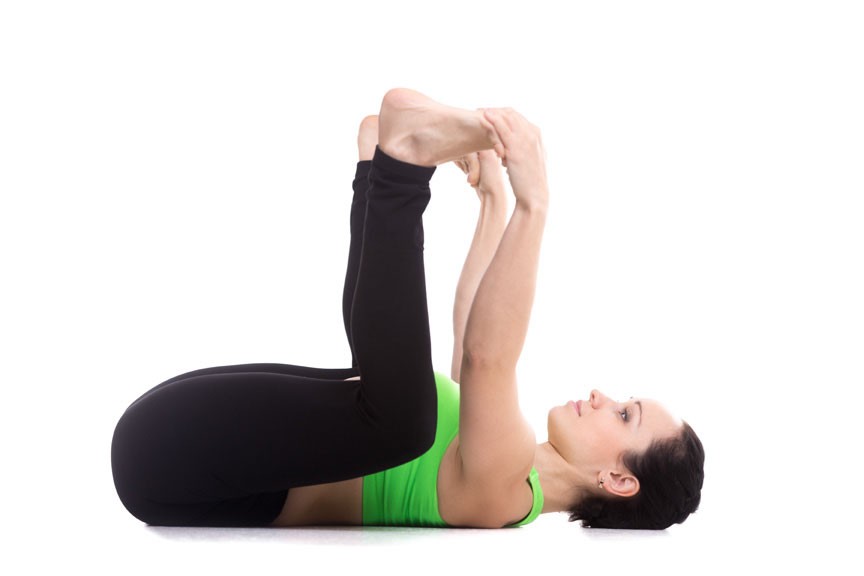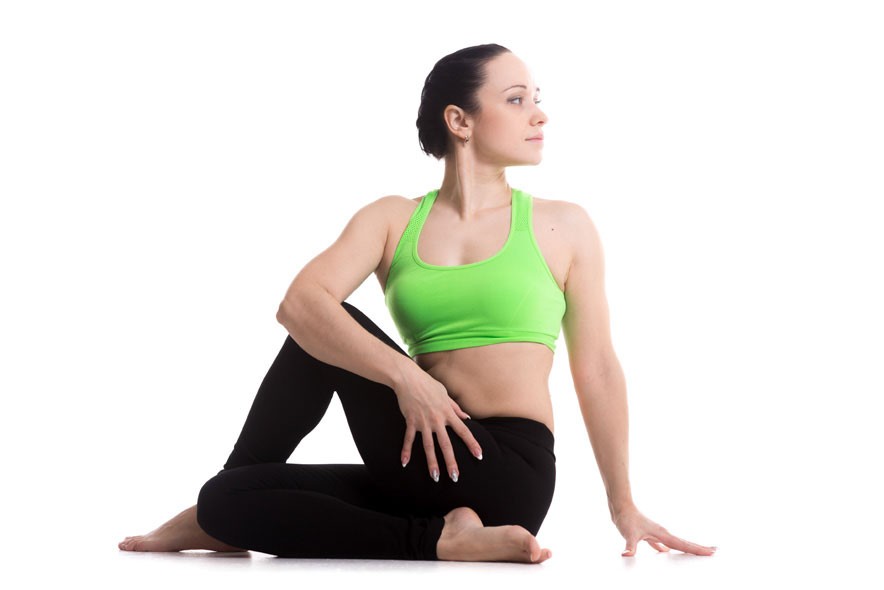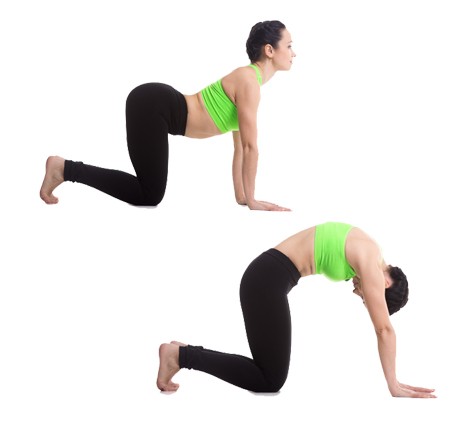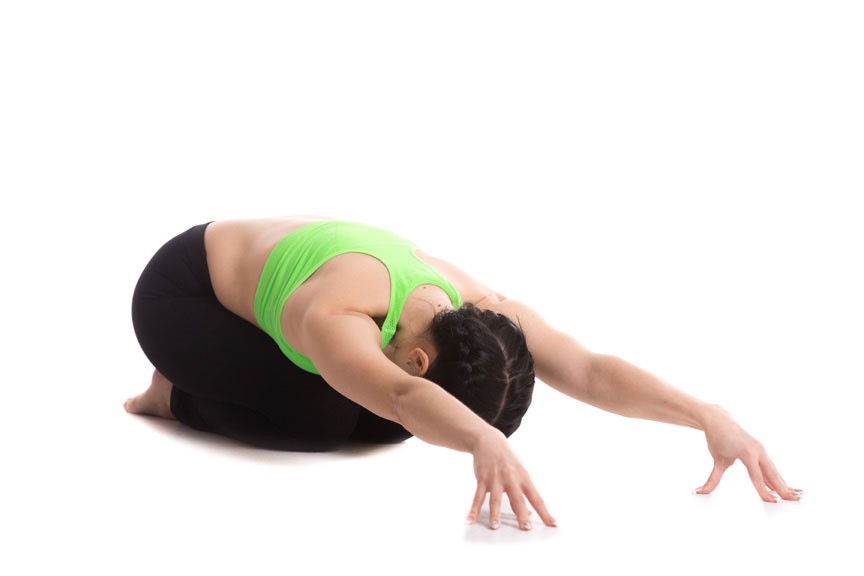Y O G A F O R D I G E S T I O N
Yoga has been my lifesaver. It has helped both my mental and my physical health tremendously and forced me to learn and regularly practice mind-body awareness, which is something I had previously actively avoided. I was upset and angry with my body for “betraying” me with uncomfortable and painful symptoms. I was also too embarrassed to go to a yoga class, despite having been a practitioner for years, as I would have to stop to go to the toilet every two minutes and didn’t want to distract the other students. There’s nothing worse than being the culprit behind a noisy stomach, or a creaky door opening when everyone is sitting in silent meditation. However, the skills I have learnt with regards to listening to my body has helped me along my health journey. I can now more accurately identify my “trigger” foods, as I am more in tune with my bodily sensations. I have also come to have a newfound appreciation for my body, for all the amazing ways it can twist, turn, go upside down … we really are blessed to have such amazing machinery to work with.
Yoga is like having a good singing voice, in that you take it with you wherever you go. Even on holidays I’m known to take up room in the boot with my yoga mat. Tough to those who object; it’s my medication. If you are too embarrassed to attend a class, or prefer privacy when exercising, then these simple yoga postures can be performed in the privacy of your own home, any time of day or night. All you need is a mat, or if you have carpet and a thick towel you’re set! These postures in particular have been shown to significantly reduce painful symptoms of indigestion and to get things moving … if you know what I mean 😉
Practicing the Yogic Breath
Start in a reclining position. This gives you a chance to practice yogic breathing through the nose. Inhale for five counts through the nose to fill the belly with air, then exhale for five counts through the nose. Do this at least five times. Take a moment to just chill out. Forget the outside world, “it will still be waiting for you when you’re finished” as my yoga instructor says. Some of these yoga poses, such as the bridge pose, are stretch moves that stimulate your abdominal organs. Next are twist poses that massage and tone your abdomen – great therapy for gas, bloating, and constipation. The remaining poses work out your back, neck and spine extensors. When your nervous system is relaxed, you will feel less stressed and your stomach muscles will relax. We’ve all heard about the mind-body connection. Well, each day there are more and more studies coming to light that demonstrate just how important our mental wellbeing is for controlling our gut health and vice versa.
Below, I have listed my top 5 yoga poses that are easy and can be performed in the comfort of your own lounge room after a large meal, first thing in the morning (highly recommended), before you go to bed, or whenever you are feeling symptoms of digestive distress.
1. Knees hugged to chest or "Apanasana"
You’ll want to do this simple stretch – also known as the wind-relieving pose – to gain relief from bloating and gas pains. You will often see babies do this on their own accord. Little geniuses! Lie down, relax and inhale through the nose, placing your hands on your knees. Exhale through the nose as you hug your knees to your chest. Rock your knees from side to side to maximise the stretch. Stay for five to ten breaths, and release your knees. Repeat this move at least five more times. To vary the stretch, you can do one side at a time. Leaving your left leg extended, bring up your right knee and hold it for five or more breaths. Then, switch to the other side. An advanced variation of this is the appropriately-named “happy baby pose” where you grab the inside or outside of your feet with your hands and pull your knees straight down to the ground. This is a more intense stretch.

2. Bridge pose or "Setu Bandha Sarvangasana"
This mild inversion increases blood flow, making you feel more energised. It also stretches out your belly muscles, which is great for when you’re feeling bloated and have been hunching over all day as a result of stomach pains. Lie on the floor and bend your knees to 90 degrees. Keep your arms beside your body and your feet flat on the floor. Slowly lift your hips up vertebra by vertebra, to give your chest a good stretch. To better aid your digestion and intensify the stretch, try this variation: Keep your hands under you as you arch your back and open your chest. You can also clasp your hands and interlace your fingers under your back, pushing down on the floor to elevate you higher. If you’re super flexy, you can even grab your ankles to help elevate your hips.

3. One-legged seated spinal twist
Since you’re doing this twist pose from a seated position, you have more control over your stretch. This stretch is particularly great for stimulating the deep intestinal organs, and helps to “move things along”. Don’t be surprised if you get a little gassy. To start, sit with your legs extended. Bend your right knee and place your heel close to your body. Reach your right arm behind you and place your palm on the floor. Your left elbow goes on the outside of the right knee to help you twist. Stay for five or more breaths, deepening the stretch every time you exhale. Then release the twist and repeat on the other side. If you’re flexy, rather than keep your untwisted leg straight, you can bend it in too.

4. Cat and Cow or "Marjaryasana and Bitilasana"
Transition between these two poses to warm up your spine and relieve the tension in your back and neck. Again, this will stretch your belly as you extend into Cow pose. Set yourself up on your hands and knees on the floor so that your shoulders are directly over your hands and your hips over your knees. Inhale, keeping your spine straight so that your abdominals are engaged (pretend to hold onto a wee so that your core is activated). Inhale as you drop your head and round your spine upwards for cat pose. On an exhale, arch your back, lifting your head and butt for cow pose. Careful not to cram into the neck. Switch back and forth between the two poses, connecting your inhale with cat’s pose and exhale with cow’s pose. Repeat at least five times.

5. Child's Pose or "Balasana
Also known as the resting pose, this is a basic move you can use for a relaxing stretch. It is great when all you want to do is hunch over in pain from an inflamed belly or for when you want to relieve wind. I also find it helps ground me if I’m experiencing a lot of mental anxiety. Stay in this position for five breaths or as long as you need. Remember to come up slowly, as some blood would have rushed to your head. To get into the pose, sit on your feet with your knees spaced wide apart to the width of your mat. Lean forward, stretching your arms in front of you, but be sure not to hunch through the neck. Then, keeping your back straight, aim to place your forehead on the floor. To make it easier to hold the pose, rest your head on a block or a pillow. Note: there is a variation of this pose, where you keep your knees together as you lean forward over them, however those with sensitive stomachs tend to find this variation less comfortable.

So there you have it Yogis! The hardest part is creating a new habit of stretching every day. Trust me when I say you will instantly notice the benefits, not just to your digestion but also to your overall physical and mental wellbeing. Flexibility is great in that its something you instantly notice improvement in … and we all enjoy doing stuff we’re good at. There are countless benefits to regularly practising yoga:
Improves flexibility & balance
Enhances muscle strength
Enhances core stability
Improves posture
Prevents cartilage & joint breakdown
Protects the spine
Improves bone health
Increases blood flow
Drains your lymphs & boosts immunity
Ups your heart rate & drops your blood pressure
Regulates your adrenal glands
Improves mood
Founds a healthy lifestyle
Lowers blood sugar
Improves focus
Relaxes the nervous system
Releases tension in your limbs
Improves quality of sleep
Increases self-esteem
Eases chronic pain
Builds awareness for transformation
Encourages self care
Supports your connective tissue
As soon as you start feeling better, you’ll actually want to do your stretches.
Let me know how you go. 😀
Note: I am a certified Vinyasa yoga instructor who holds certificates III and IV in fitness. I am especially passionate about yoga for digestive health and you are always more than welcome to get in contact to book a private or small class session. There are also a number of fantastic free Yoga tutorials on Youtube. Just be sure to choose your tutorials according to your level. Leave your ego at the door … this is about promoting lifelong health and wellbeing and preventing (not welcoming) injury.
